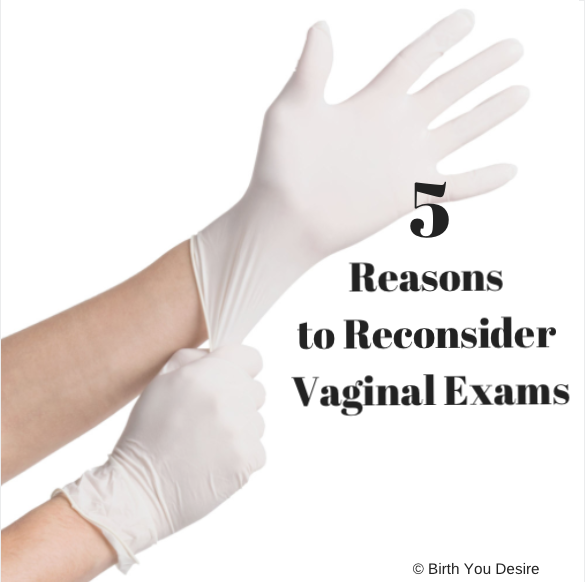5 Reasons to Reconsider Vaginal Exams

5 Reasons to Reconsider Vaginal Exams
Vaginal exams are so commonplace in our current maternity system that we never stop and think about their advantages or disadvantages. In fact, many women are not aware that they have choices around accepting or declining vaginal exams. Here are 5 reasons to reconsider your assumptions about vaginal exams.
They aren’t accurate.
No two people, two uteruses, two cervixes, or two babies are the exact same. And even though medical students are all taught and practice vaginal exams the same way, each provider has a different level of skill when it comes to accuracy. Three variables can affect exam accuracy.
One, your position can affect accuracy. A mother who is examined on her side or squatting may receive a different exam than if they was in a more traditional position such as on her back. Provider proficiency with exams can be challenging depending on her position.
Two, fetal alignment can impact how a cervix dilates and effaced in labor. A posterior baby, for example, will present a large surface area as it entered the pelvis, and dilation and effacement may not follow standard expectations.
Third, measuring during a contraction may provide a different exam than when not contracting. I don’t typically recommend this but experience with clients, especially when getting the urge to push, has demonstrated an exam while contracting (although not comfortable) can actually prove to be significantly different than when not contracting.
They don’t accurately predict labor.
Vaginal exams may tell you how dilated and effaced your cervix is, but that information is not an accurate predictor of the start of labor. First-timer can be walking around between 0-4 cm and not in labor. I have had repeat clients walking around dilated 6-8 cm and not in labor. I also have had clients who were not dilated at all have quick spontaneous births.
If your care provider does perform or offer vaginally exams during pregnancy, understand the exam only tells you numbers. It is not a prediction or offers any insight into when and how labor will happen.
It might disappoint you.
The textbook definition of labor is contractions that cause cervical change. Contractions that do not result in change are considered Braxton Hicks or latent labor.
BH contractions can start as early as 18 weeks pregnant. They get progressively more common and stronger as your pregnancy continues. And it is not uncommon for them to even steal your breath at the end of a pregnancy. Despite this, you may not be experiencing cervical change. Latent labor can last for days and for some, weeks.
Recently I had a client who had been having BH contractions for weeks. They were more frequent during the night and spaced out during the day. Every two or three contractions were strong enough to stop the mother in her steps.
One night they were every 3-5 minutes and each one was lasting a minute. Upon arriving at the hospital she was dilated 1 cm. What do you think her mental state was? “1 cm only, really? How could it be after weeks of hard work that the cervix was not just ready to have this baby?” Her disappointment was real and not to be overlooked. Side note- she did go on to have a beautiful birth several hours later.
Learn about the stages of labor and get our stagesof labor chart in our VIRTUAL comprehensive birth classes!
They can cause infection.
Frequent unnecessary exams can introduce bacteria from the vagina or the perineum to the uterus. Both GBS ( group B streptococcus) and Chorio (chorioamnionitis), may benignly exist and not cause you any health risks. But once your bags of water has broken the baby’s first line of defense is no longer present. Providers do practice sterile techniques, but even sterile techniques may not be sufficient when bacteria are present.
Failure To Progress is a leading cause of cesareans.
No two women, children, or cervix are the same. Some women, some babies, and some cervixes may need additional time in labor. Oftentimes longer labor will play out perfectly without any interventions. Sometimes, intervention can help facilitate a vaginal delivery, and rarely, mothers and babies may need a cesarean. But slow labor may not be a reason for a cesarean. And spaced our vaginal exams can allow women and babies to have the time they need in labor to coordinate and cooperate for a vaginal delivery.
Final thoughts
As a doula, I can tell you that dilation is an important factor but the least important one to my clients. The Station of the baby in the maternal pelvis is more important to me than dilation or effacement. Once the baby is low in the pelvis the cervix will usually respond with dilation and effacement.
Trust your body. Trust your baby. Together you will navigate birth and arrive on the other side healthy and happy.
